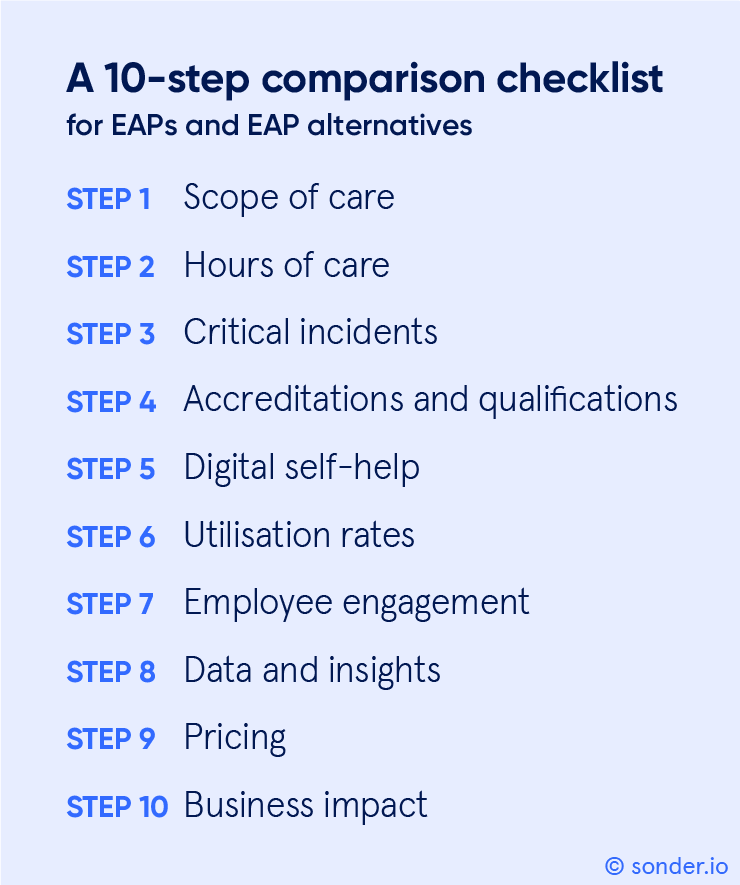It’s hard to put a price on employee health and wellbeing. Nevertheless, price is usually a key factor in procurement processes for employee wellbeing support. But, how do you evaluate the different pricing options and avoid nasty surprises that blow out your budget mid-contract?
According to the Productivity Commission, even the best leaders can be uncertain about how to choose an EAP (or EAP alternative) to achieve the best outcomes for both their people and the organisation. Especially since they noted that “the monitoring and evaluation of EAPs was at best patchy or perhaps even insufficient and inadequate”.
To help you decide how to meaningfully invest your EAP budget, this blog post shares a five-step process for EAP pricing reviews, two common EAP pricing models, and news of a comprehensive guide to help you compare apples with apples – and avoid nasty surprises.
“As a mid-sized company, it hit us hard when we had to pay $55,000 after two critical incidents in our stores.”
HR Manager
Retail industry
5-step process to evaluate EAP pricing proposals
This five-step process can give you confidence in your business case and final decision, as well as ensure accountability and thoroughness in your process:
Step 1: Gain executive buy-in on how pricing will influence the final decision, and in what circumstances a higher price is approved.
Step 2: Articulate the expected versus goal utilisation rate for your organisation.
Step 3: Factor in all of the ‘added extras’.
Step 4: Run financial modelling scenarios (including higher-than-expected utilisation), based on different pricing models.
Step 5: Compare those results not only to each other but to the financial risk of not investing in employee wellbeing support.
“Our old EAP provider sent an unexpected bill for $178,000. I nearly lost my job over that.”
Senior People Leader
Professional services industry
EAP pricing models
The two most common pricing models for EAPs (and EAP alternatives) are “fee-for-service” (otherwise known as “pay-for-use”) and “fixed” pricing.
At Sonder, we use fixed pricing. We believe it’s the most attractive way to price our EAP alternative services for organisations that genuinely want high employee uptake and better safety, health, and wellbeing outcomes. Employers who are only interested in basic coverage and low employee usage rates might be best to consider “fee-for-service” providers instead.
To help explain the two pricing models, we’ve created a handy comparison chart for how fees are calculated, how billing is organised, how variances are accounted for, and the general pros and cons of each pricing option.
In a nutshell, the key benefits of a fixed pricing model are:
- Usually a lower annual cost if the usage of the service is high;
- Usually higher utilisation rates because the employer is motivated to encourage high usage; and
- No surprises, with predictable billing and budget requirements.
Versus, the key benefits of a fee-for-service pricing model are:
- Potentially lower upfront fee;
- Can be easier to gain procurement sign-off upfront (even if the annual cost works out higher later); and
- Might be the cheaper option if employee usage is low.

????Insider tip: Most organisations get stung when their usage goes above estimates. To avoid exceeding your budget unexpectedly, always overpredict requirements.
Comparing apples with apples
Often, decision-makers are not comparing apples with apples when they’re weighing up provider proposals, because on paper, it’s easy to think that all EAP (or EAP alternative) services are the same. In reality, they can be very different.
That’s why we’ve put together a super-comprehensive report that walks you through what to ask and what to look for, and helps you make an informed and defensible decision.
The report contains a 10-step comparison checklist and is a must-have for decision-makers comparing EAP and employee wellbeing services.

Download our deep-dive report
Today’s blog post shares excerpts from our new ‘How to compare EAPs’ guide, which we invite you to download here. This insider’s guide to employee assistance programs will help you:
- Define a typical EAP offering
- Summarise why employee uptake has been low
- Discover what makes EAP alternatives different
- Learn how to compare vendor offerings
- Gain insider tips and statistics
- Write a convincing business case
How to compare EAPs
The most comprehensive buyer’s guide, ever!
How is Sonder different from an EAP?
Sonder is an EAP alternative. We combine mental health support with safety and medical support. We also combine on-demand technology with 24/7 human expertise, as explained in our video:
For more information about how Sonder can help you rethink your employee and/or student support, we invite you to contact us here.
About Sonder
Sonder is a technology company that helps organisations improve the wellbeing of their people so they perform at their best. Our mobile app provides immediate, 24/7 support from a team of safety, medical, and mental health professionals – plus onsite help for time-sensitive scenarios. Accredited by the Australian Council on Healthcare Standards (ACHS), our platform gives leaders the insights they need to act on tomorrow’s wellbeing challenges today.



